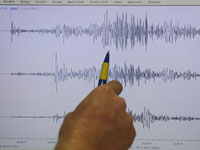New Earthquake Makes Residents of South Pacific Islands Uneasy
A magnitude-7.8 earthquake triggered a tsunami warning for nations across the South Pacific, nine days after destructive waves killed about 140 people in Samoa.

Authorities evacuated tourists and locals on some low-lying Pacific islands, including Fiji and New Caledonia, before the alert was canceled. There were no immediate reports of damage or casualties.
The warning was triggered by a temblor that struck off Vanuatu at 9:03 a.m. local time, followed by a quake measuring 7.7 about 15 minutes later, according to the U.S. Geological Survey. Aftershocks measuring 7.3 and 6.9 were also recorded. Tsunami waves as high as 10 centimeters were seen in Vanuatu, according to the Pacific Tsunami Warning Center, which canceled the regional alert about 2 1/2 hours after the initial quake.
“It was pretty calm, nobody was too distressed,” said Australian tourist Steve Handley, 22, who was staying at the Mango Bay resort in Fiji, where hotel workers told guests to seek refuge on a nearby hill, about 100 meters above sea level.
In New Caledonia, the port of Koniambo was evacuated and workers in vessels were advised to take precautions.
Once the tsunami warning was lifted, the site began returning to normal operations. Xstrata, the world’s fourth-largest copper supplier, is developing the $3.8 billion Koniambo nickel mine in New Caledonia and is due to start producing ore in 2012, according to Bloomberg's report.
Subscribe to Pravda.Ru Telegram channel, Facebook, RSS!





